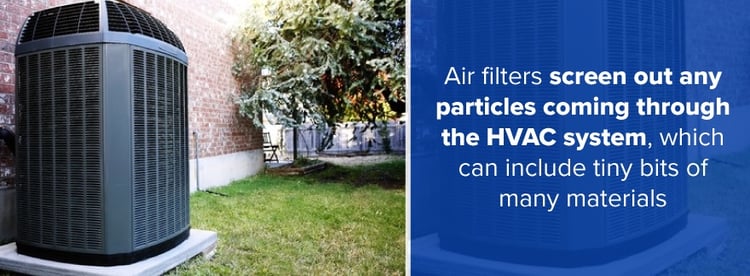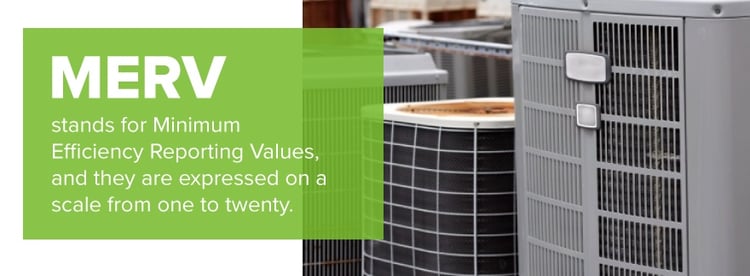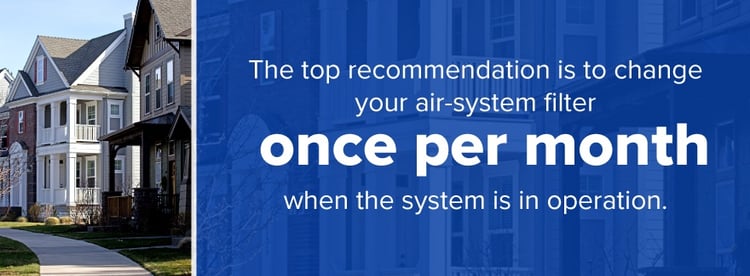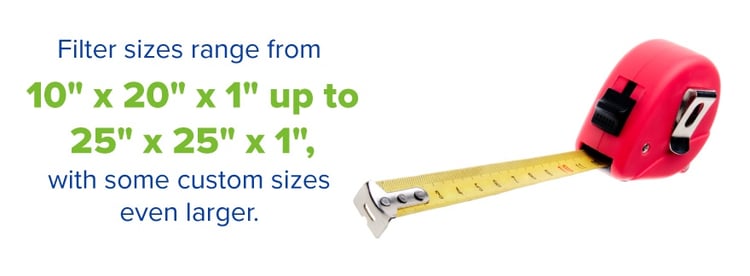
Any home or structure that has conditioned air running through duct work also has an air filter that needs to be changed regularly.
The air filter stands as an unobtrusive sentry of home air, and they’re often so out of sight and mind that we forget about them. Filters of many sizes and varieties serve the purpose of preparing the air for circulation, removing dust and other particles as air is forced to or from the heating or cooling mechanism and through the vents.
A dirty or clogged air-system filter has a substantial effect on the operation of your heating, ventilation and air-conditioning (HVAC) system. If it is wintertime, the furnace must work harder to force the air through the filter and burns more fuel to do its work. If it’s scorching outside, the air-conditioning compressor and all its components will work harder to deliver the air to your home.
Whether you rent or own your home, changing your air filter is important to your comfort, to the system running right and to the longevity of your HVAC components. HVAC filters, the mechanical parts, and ductwork in your home are all key elements that affect the quality of the air you breathe in your home.
Here are the answers to 10 common questions you might ask about your air filters and how your system works:
-
What Can Go Wrong?
Air filters are a fairly straightforward device with a simple function, but they need to be clean enough to do their job effectively. There are many problems that can result from a dirty air filter, such as:
- Dust and particulates enter the system and accumulate on the mechanical components like the fan blade and motor.
- Dirt and allergens build up on the walls of your duct work.
- Coils of your system become clogged or blocked with dirt.
- Coils of your system become frozen due to lack of air flow.
- Poor performance and low efficiency cost you more money.
- A bent or ill-fitting filter allows dirt to bypass the filter.
Proper care of the air filter is essential maintenance that will help ensure efficient operation of the system and the life of its mechanical parts. Once you know what kind of filter you have, its dimensions, and how to change it the task becomes quick and easy — and all the dirt stays within the fibers of the filter where it should be.
-
How Do Air Filters Affect Indoor Air Quality?

Air filters screen out any particles coming through the HVAC system, which can include tiny bits of many materials, some of them microscopic. Home-air pollutants are generally some kind of particulate matter, but sometimes they also take gaseous form. There are many things that affect indoor-home air quality (and a long list of potential others for commercial business), including:
- Dust
- Mites
- Spores
- Mold
- Viruses
- Ash
- Pollen
- Pet dander
- Bug parts
- Hair
- Lint
- Tobacco, wood or food
- Pesticides
- Paint or similar vapors
- Fumes from cleaning products
You can probably think of other things that may enter or circulate through our home. While some of it is inevitable, you can choose to invest more in a filter and get better quality air. The most basic filters work mostly to protect the HVAC system and actually don’t do a lot to improve indoor air quality.
-
Is It the Same Filter for Heat and AC?
Yes. The term HVAC filter applies to heating and cooling systems alike because it usually serves the furnace and air-conditioning unit. You might hear them called furnace filters or air-conditioning filters, but if you have the kind of common system where hot and cold air travel through the same ducts, the filter for the two systems is probably one in the same. Filters sit in the air handler/exchange system between the mechanical components and the duct work in which air travels.
-
What Kinds of Filters Are There?

Air filters vary broadly by material, cost, size and function, so most consumers benefit from some information to guide their decision on what kind to buy. Before you delve into the different kinds of filters, get to know MERV.
MERV stands for Minimum Efficiency Reporting Values, and they are expressed on a scale from one to twenty. Lower numbers mean a lower quality filter, and the higher numbers indicate the filters that eliminate smaller particles — at the micro-level matter. Different types of filters include:
- Mechanical/flat filter: This filter is probably most common. It is usually some kind of disposable fiberglass inside a cardboard frame that costs somewhere around one or two dollars apiece. It offers about a 75% rate of efficiency removing large particulate matter and practically no effectiveness at removing fine particles. It has a MERV rating of 2.
- Pleated filter: This popular type looks like its name and is made of a disposable polyester-cotton blend paper. It removes nearly 100% of the large particles, and if it has a good “dust-spot efficiency” rating, it can also remove about 50% of the small matter such as mites and spores to improve air quality. Pleated filters cost four or five dollars each and in theory can be replaced less often than a flat. In reality, however, if they’re dirty twice a month, they should be changed twice a month — the tighter weave of the filter does a good job of filtering out particles but becomes full and clogged faster.
- Disposable electrostatic filter: This consists of self-charging cotton or paper fibers with a MERV rating of 10, and they cost about $10 each. It has a 75%-95% effectiveness rate on large particles and up to 15% with small ones, using friction to catch them.
- Permanent electrostatic filter: This filter also consists of self-charging cotton or paper fibers or sometimes a plastic blade-like piece. They cost $10-$15 apiece and have a MERV rating of 8. Like the disposable filter, it has a 75%-95% effectiveness rate on large particles and up to 15% with small ones.
- Electronic filter: This one uses a high-voltage charge from a power source rather than static electricity. It is a good choice for people who suffer from allergies and has plates you remove to clean regularly. It gives more than 95% effectiveness for large particles and from 75%-95% on the smaller matter. This filter has a MERV rating about the same as its electrostatic cousins at 8-10. It contains a pre and post filter, both of which range in cost from $36 to $100 each depending on the setup for the air cleaner.
- HEPA filter: This top-of-the line filter is called by its acronym, which stands for what it is and does: High-Efficiency Particulate Arresting filter. It is made of dense, thick cotton or polyester blends and catches just about everything including dust, mold, spores, bacteria, hair and dust with a greater than 95% effectiveness rate of removing small and large particles. System installation is a high expense, and then the system has one filter you change every one-to-three years as well as a pre-filter you change two or three times per year. A HEPA filter costs around $100 and has a MERV rating of 16-20.
Typically, the highest-end filters are used in settings such as hospitals, clean rooms, electronics manufacturing and other such operations. There are also bag-type air filters, which are typically found in a place such as a paint booth, for example. With most residential technology, you can achieve a MERV rating of 3-10 and go higher with the right system if someone in the house has allergies, immune issues or respiratory problems.
The Environmental Protection Agency states: “Filters with a MERV between 7 and 13 are likely to be nearly as effective as true HEPA filters.” Following that logic, a permanent or disposable electrostatic filter would be a good upgrade that costs less than going to true HEPA filtration.
-
How Often Should I Change My Filter?

Setting a schedule for when to change your filter will vary depending on your system and preferences. The top recommendation is to change your air-system filter once per month when the system is in operation.
Some people pick a date and then write it on a paper calendar or set some kind of digital reminder to change the air filter. You can easily find other advice that says to change the filter when it’s dirty, quarterly or before the hard seasons of winter or summer, but the best answer is a proactive approach that gets the filter changed regularly and doesn’t let it get too dirty.
-
How Do I Know Which Filter to Get?
Picking the right filter for your family requires self-assessment. Asking some basic questions about your home might help guide your decision to the right kind of filter:
- How many people live in the house?
- How often is the house cleaned?
- Are you near fields, roads or other dusty areas?
- Do you have pets in the house?
- Does anyone smoke in the home?
- Is the activity level in the house high/medium/low?
- Do you or other family members suffer from allergies?
- What do you think of the general air quality in your home?
Any or all of these factors might affect the kind of filter you decide to have and how often you change it.
-
Where Do I Find the Filter?
There is a lot to be aware of as you select replacement filters for an existing system or make a change to something new or different. The most common mistake people make with air filters is to buy the wrong size or put it in backward.
The surest way to the right replacement is to look at the old filter, and to do that, you have to find it. Normally, it is located in or near the air handler — the area where cool or hot air is exchanged and comes into the ducts. Depending on how your system is configured, the handler might be in the attic, basement, wall, or ceiling and the filter should be within, beside, underneath, or on top of the air exchanger. Filter sizes range from 10" x 20" x 1" up to 25" x 25" x 1", with some custom sizes even larger.

Sometimes the filter is behind a drop-down door or within a unit secured by two screws. It usually has a cardboard or plastic frame and is one to two inches thick, but some filter types can be up to five inches thick. It’s possible you might find an empty slot where the filter should be but isn’t — that will require you to measure the opening to find the exact dimensions for the necessary filter.
-
How Do I Change an Air Filter?
Correct installation of the filter is as important as changing it regularly. First, turn off the air system and find the filter. Before you pull the filter out, make a literal note of how it is situated in its slot. Use a permanent marker to draw an arrow onto the frame that holds the filter so you don’t lose track of the correct air-flow direction and can match it to the arrows that are on most filters.
The majority of HVAC filters do not have a dual-sided design and must be inserted a certain way or they lose their effectiveness. The drawn-on arrow helps combat the human error of not paying attention when we remove the filter and then end up thinking, “Now which way did that go in there?” The good news is, once you have done it once or twice, changing air conditioning filters (or furnace filters) becomes a quick-and-easy task.
-
What Size of Filter Should I Get?
Along with directional arrows on the air filter, usually on the edge printed onto the cardboard frame, should be numbers that express length, width and thickness. You might have to jot these down the first few times you buy filters, but after a while, you will know them by heart — like a phone number or password.
Buy the exact-sized filter you need and be sure it fits into the slot snugly. Sometimes when people buy the wrong size by mistake, they’re tempted to bend or fold the filter to fit. That is not a good practice, however, because it allows air to bypass the filter and for dirt and other particulate matter to enter your HVAC system.
If you happened to move into a place where the filter slot is empty, use a tape measure to determine the length, width and thickness. If you decided to change to a different type of air filter, make sure its dimensions match the slot your HVAC system has. You can also consult an HVAC professional to convert your system so it accommodates the kind of filter you would like to use.
-
How Do Air Filters Help Me Save Money?
The air filtration of your HVAC system has the potential to protect the components from dirt, debris, and breakdown, as well as prolong their life. Filters can also improve indoor air quality to alleviate allergies and provide special environments — as well as help you save money on your energy bill.
One of the EPA’s recommendations for a lower energy bill is to change the system filter monthly. Basically, the harder your system works to process and deliver the air, the more energy it will use and the more money it will cost. With the air filter being such an integral part of the system for the mechanical and human aspects, it pays in the short and long run to maintain the filter well.
Breathe Easier
Anytime you need a trusted partner for a tune up, upgrade or general air-conditioning service and repair, don’t hesitate to contact Smart Touch Energy.
We put energy at your fingertips and bring a company culture based on innovation, responsiveness and commitment to our customers. Smart Touch Energy can assist with many of the things that are essential to your comfort and to a well-maintained home.



